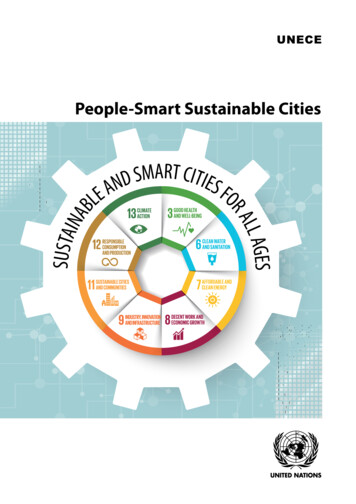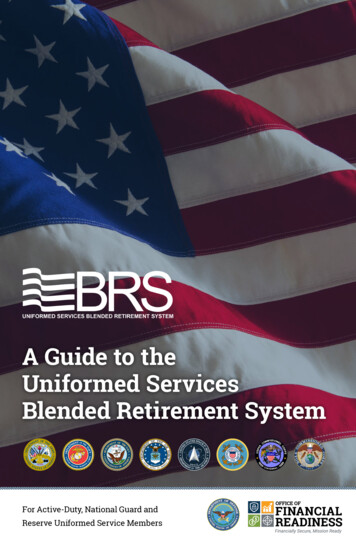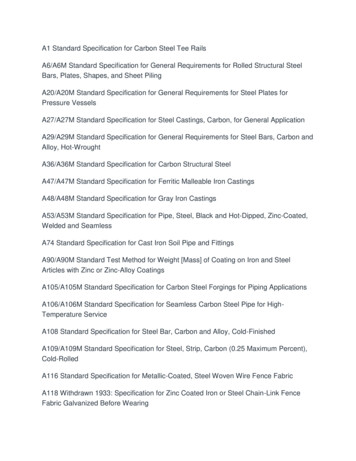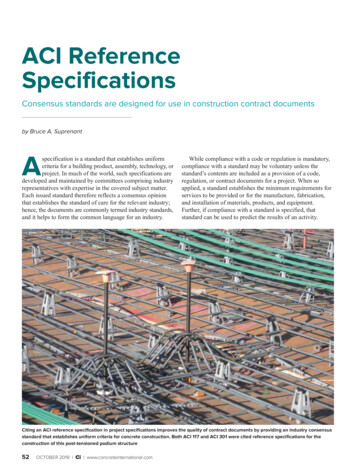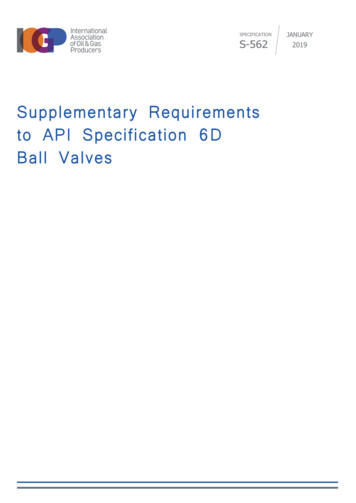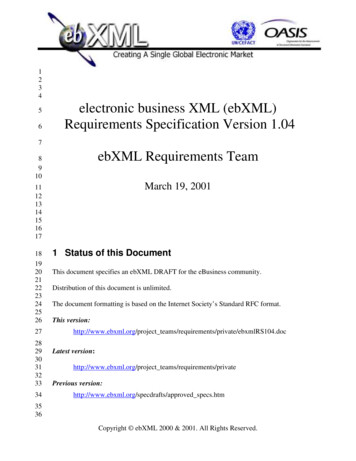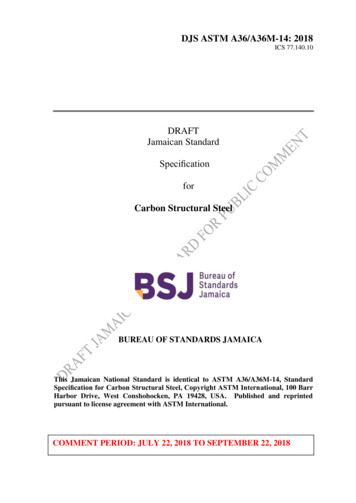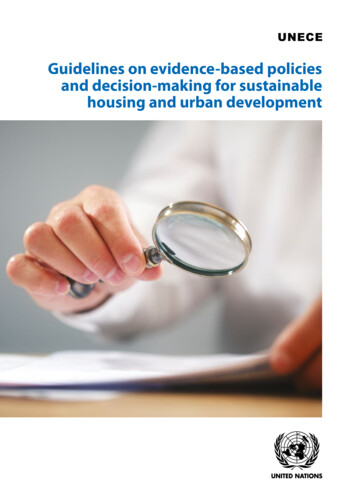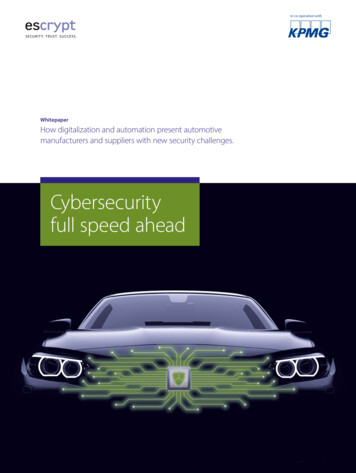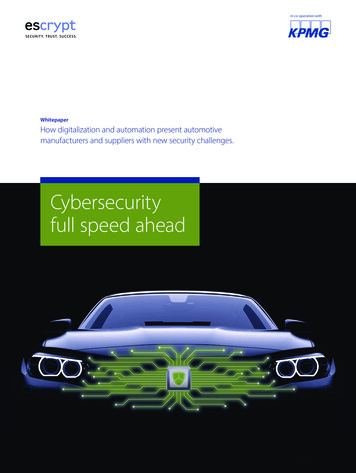
Transcription
FinalSeptember 2018UNITED NATIONS ECONOMIC COMMISSION FOR EUROPEUNITED NATIONS CENTRE FOR TRADE FACILITATIONAND ELECTRONIC BUSINESS (UN/CEFACT)BUSINESS REQUIREMENTS SPECIFICATION(BRS)Purchase Order FinancingVersion: 1.00
Purchase Order Financing RequestDocument SummaryDocument ItemCurrent ValueDocument TitleBusiness Requirements Specification Purchase Order FinancingRequestDate Last Modified10-APR-2018Current Document Version1.00StatusFinalDocument DescriptionSpecification that describes the business processes and requirementsfor the Purchase Order Financing Request.Log of ChangesIssue No.Date of Change0.00.0111 October 2015First draft0.00.0217 March 2016Feedback from team members and stakeholders0.00.0306 February 2017Feedback from team members and stakeholders1.00pr12 February 2017Draft for public review1.0010 April 2018Feedback from public review and teammembers06-Feb-2017Changed ByUN/CEFACTSummary of ChangePage 3 of 20
Purchase Order Financing RequestTABLE OF CONTENTS1.2.3.4.5.BUSINESS REQUIREMENTS SPECIFICATION (BRS) . Error! Bookmark not defined.Preamble . 5References . 5Objective . 5Scope . 6Business Requirements View . 75.1. Business Process Elaboration . 85.2. Information Flow Definition. 125.3. Information Model Definition . 2006-Feb-2017UN/CEFACTPage 4 of 20
Purchase Order Financing Request1.PreambleThis document describes the Purchase Order Financing request process being a part of thepayment process for financing the trading parties that lack the funds to pay their suppliers such asthe customer and the supplier in the supply chain process.2.3.References UN/CEFACT. Techniques and Methodologies Group (TMG). CEFACT’s Modelling Methodology(UMM): UMM Meta Model – Foundation Module. (Candidate for 2.0). 2009-01-30 Common Supply Chain Requirements (BRS) Business Requirements Specification (BRS) Documentation Template, version 2.0ObjectiveThis document aims to define the Business Processes and the Business Transaction of thePurchase Order Financing in the supply chain finance.The Business Process is the detailed description of the way trading partners intend to play theirrespective roles, establish business relations and share responsibilities to interact efficiently with thesupport of their respective information systems.Each Business Transaction is realized by an exchange of Business Documents (also calledmessages). The sequence in which these messages are used, composes a particular instance of ascenario and are presented as use cases in the document.The business documents are composed of Business Information Entities (BIE), which are preferablytaken from libraries of reusable business information entities. The BIEs are out of scope of thisdocument.The purpose of the project is to develop a UN/CEFACT business standard guidelines for PurchaseOrder Financing (also known as pre-shipment finance) request.Purchase Order Financing (POF) is a financing option provided by a finance provider for tradingparties that lack the funds to pay their suppliers (e.g. manufacturers), or Sellers that need cash inadvance and on this basis can also offer extended payment terms to their Buyers. A purchase orderfrom an acceptable buyer is a key ingredient in motivating the finance in addition to the ability of theseller to perform under contract with the buyer. Once payment is collected from the buyers whosigned the purchase orders, the purchase order financing company will be reimbursed for its outlaysand collect its fee. Purchase order financing is a variation on factoring, which is typically based oninvoices.06-Feb-2017UN/CEFACTPage 5 of 20
Purchase Order Financing Request4.ScopePurchase order financing covers the working-capital needs for the seller, including procurement ofraw materials, labour, packing costs, and other pre-shipment expenses in order to allow the sellerto fulfil delivery to its buyer(s). Financing can be provided against purchase orders (confirmed bybuyer or unconfirmed), demand forecasts or underlying commercial contracts. It can be covered bya banking credit line or by other financial agent, which caters for direct payment to thesupplier (Bank and non bank finance providers are active in this type of financing particularly inAsia 1).POF is normally used on the basis of competitive service levels (e.g.: rate, duration) and it is similarto invoice financing, but with a different risk management standing.The parties involved in the exchange of data are the customer (buyer or payer), the supplier (selleror payee) and his financial institution (or financial agent).uc PurchaseOrderFi.«ProcessArea»PurchaseOrderFina (from hBusinessAgreementOrderShipPayFigure 4-1 Positioning Purchase Order Financing Request within BUY-SHIP-PAY Process ModelCategoriesDescription and ValuesBusiness OrderFinancingProduct ClassificationAllIndustry ClassificationAllGeopoliticalGlobalOfficial ConstraintNoneBusiness Process RoleCustomer, SupplierSupporting RoleCustomer’sBank, Supplier’sBankSystem CapabilitiesNo limitationsIn the payment cycle the transfer of funds takes place between the customer and the supplier insettlement of the amounts that are due for the supply of goods and services.1Standard Definitions for Techniques of Supply Chain Finance, GLOBAL SUPPLY CHAIN FINANCE FORUM06-Feb-2017UN/CEFACTPage 6 of 20
Purchase Order Financing RequestPurchase order financing is a short-term commercial finance option that provides capital to paysuppliers upfront for verified purchase orders.The following functions comprise the request cycle (phase#3 of the figure 4.2): The generation of the Purchase order financing request based on orders that have to beexecuted between the supplier (requestor) and the customer; The communication of the Purchase order financing data between the supplier and thefinancing agent; The communication of the Purchase order financing approval between the financing agent andthe supplier. The reconciliation by the supplier of the purchase order financing.To simplify the description, the parties involved are limited to customer, supplier and supplier’s bank.In the total trade process, each of the parties can play more than one role. For the payment cycle,the customer can act also as consignee, invoicee and payer. The supplier can cover the roles ofseller, consignor, sales agent or sales company.In order to provide an overview of the Purchase Order Financing Service model, a businessscenario has been identified, where the Financing Requestor submits Purchase Order FinancingRequest to the First Financial Agent; these two are the only actors involved in the message flowswithin this scenario (phase #3 of the figure 4.2).According to the service level agreed, the First Financial Agent may use Financing Request Statusmessages to give the Financing Requestor information about the requests status.Figure 4.2 - Typical scenario worflowIn particular, the Financing Requestor (i.e. the account owner) sends the purchase order financingrequest to his bank (Financing Agent). After presentation of the purchase order financing request,the First Financial Agent completes preliminary checks and sends a first "status report" message tothe Financing Requestor.Subsequently, the First Financial Agent completes all necessary checks in order to allow financingand communicates to the Financing Requestor the final result of the financing request (eg financed,not financed).5.Business Requirements View06-Feb-2017UN/CEFACTPage 7 of 20
Purchase Order Financing Request5.1.Business Process Elaborationuc Purchase Order«BusinessProcess»POF Request«parti ci ti cipates»«BusinessProcess»Order award«partici pates»«participates»CustomerSupplierThis busi ness processis not elaborated furtherin this BRS.Figure 5-1 Business Domain Use Case Diagram5.1.1.Purchase Order Financing ProcessThis process supports the generation and communication of the Purchase Order Financing request bythe supplier to the financing agent. The Order is related to a payment, or other form of financialsettlement, in respect of the provision of goods, services provided by the supplier, or othertransaction involving a payment.5.1.1.1. ScopeThe Purchase Order Financing (POF) will be used to allow the supplier to inform the financing agentof detailed information relative to an order.The POF will give an overview of the i n f o r m a t i o n that are taken in account in the financing processby supplier bank. It also specifies the identification and the requested execution date of the PaymentOrder.06-Feb-2017UN/CEFACTPage 8 of 20
Purchase Order Financing Request5.1.1.2. DefinitionThe POF process is the mechanism by which the supplier informs his financing agent about theorder details to be financed. This process should be related to the process of transfer of fundsbetween the parties (customer and supplier) and the respective banks specified in the payment orderprocess.Figure 5-2 Business Process Use Case Diagram5.1.1.3. PrinciplesAccording to the service level agreed, the First Financial Agent may use Financing Request Statusmessages to give the Financing Requestor information about the requests status.In particular, the Financing Requestor (ie the account owner) sends the purchase order financingrequest to his bank (First Financial Agent). After presentation of the purchase order financingrequest, the First Financial Agent completes preliminary checks and sends a first "status report"message to the Financing Requestor.Subsequently, the First Financial Agent completes all necessary checks in order to allow financingand communicates to the Financing Requestor the final result of the financing request (eg financed,not financed).Assumption of this scenario is that the Buyer has already sent an order to the Seller, related to atrade transaction.06-Feb-2017UN/CEFACTPage 9 of 20
Purchase Order Financing Request5.1.1.4. Use case descriptionBusiness process namePurchaseOrderFinancingIdentifierPurchase Order Financing RequestActorsCustomer, Supplier, Financing AgentDescriptionPre-conditionAssumption of this scenario is that the Supplier and the Buyer have alreadysinged an order, related to a trade transaction.Post-conditionsThe supplier is adequately informed about the order being settled bythe payment being made.ScenarioRemarks06-Feb-2017a buyer awards a seller a large purchase order. From a business standpoint,the purchase order is one that the seller can’t afford not to accept, but from acash flow standpoint, it is one that the seller can’t afford to produce. For thatthe seller contacts a PO finance company and supply them with financialinformation about the company, the supplier and the buyer (customer).Next, the finance company pays the supplier(s) directly by posting a letter ofcredit that guarantees payment once they deliver to the buyer. Once theorder is delivered the buyer remits payment directly to the finance company.From that payment, the finance company recovers its capital, deducts its feeand sends to the seller the balance, the seller’s profit.In most cases, purchase order financing could be combined with invoicefactoring.Based on the agreed payment conditions between the parties, there is oneactor playing the role of Financing Requestor and one agent playing the roleof First Agent (Financial Agent).The Financing Requestor can act on behalf of a Supplier or can be thesupplier.In particular, the Financing Requestor (ie the account owner) sends the orderfinancing request to his bank (Financial Agent).After presentation of the order financing request, the First Financial Agentcompletes preliminary checks and sends a first "status report" message to theFinancing Requestor. Subsequently, the First Financial Agent completes allnecessary checks in order to allow financing and communicates to theFinancing Requestor the final result of the financing request (eg financed, notfinanced)UN/CEFACTPage 10 of 20
Purchase Order Financing Request5.1.1.5. Business Process Activity diagramThis shows the activities carried out by the Supplier and First Financial Agent in the exchange ofpurchase order information and the state of the financing.Figure 5-2 POF - Business Process Activity Diagram06-Feb-2017UN/CEFACTPage 11 of 20
Purchase Order Financing Request5.2.Information Flow Definition5.2.1.Issue Purchase Order Financing request (Business Transaction)5.2.1.1. Business Transaction - Use Case DiagramThe POF Process consists of a single Business Transaction. Figure 5.3, below shows theBusiness Transaction Use Case and the links between the Supplier and his bank and the authorizedroles of financing requestor and First Financial Agent.uc pplierFinAgentFigure 5-3 IssuePurchaseOrderFinancingRequest - Business Transaction Use Case5.2.1.2. Business Transaction - Use Case DescriptionBusiness questDescriptionThe Purchase Order Financing Request message is issued by the FinancingRequestor (Supplier) and represents a financing request related to an ordersignd between the supplier and the customer. For every order it is alwayspossible to identify a supplier and a buyer (customer)Authorized Roles-Supplier-FinancingAgentLegal Steps/RequirementsNoneEconomic ConsequencesNoneInitial/Terminal Events Initial: the supplier sends the Purchase Order Financing Request Terminal: the Financing Agent receives the Purchase Order Financing Request.06-Feb-2017ScopeThe POF request message is used to exchange general information related tothe order and to the financing requestBoundaryNot defined yetConstraintsFailing this technical acknowledgement, the supplier shall re-issue his requestmessageUN/CEFACTPage 12 of 20
Purchase Order Financing Request5.2.1.3. Business Transaction - Interaction ViewThis activity diagram shows the POF request “Information Envelope” that is provided by the supplier tothe financing agent.The data content of the “Information Envelope” should be specified in the Information Model (partiallyprovided in this BRS).Figure 5-6 Issue POF request e 13 of 20
Purchase Order Financing Request5.2.2.Issue Purchase Order Financing status (Business Transaction)5.2.2.1. Business Transaction - Use Case Diagramuc plierFigure 5-5 IssuePOFstatus - Business Transaction UseCase5.2.2.2. Business Transaction - Use Case DescriptionBusiness atusDescriptionThe PurchaseOrderFinancingStatus message flows from the FinancingAgent to the Financing Requestor to provide information about a requestpreviously sent.Its usage will always be governed by a bilateral agreement between theFinancing Agent and Requestor.Authorized RolesFin AgentSupplierLegal Steps/RequirementsNoneEconomic ConsequencesNoneInitial/Terminal Events Initial: the Financing Agent sends the Purchase Order Financing Status Terminal: the Supplier receives the Purchase Order Financing Status.ScopeThe POF status message can be use two fold:To provide information about the reception status (rejection,acceptance) of a request message (technical validation) - preliminary.-06-Feb-2017To inform the Requestor about the business status of the request(granted, pending, allowed or denied)BoundaryNot defined yetConstraintsFailing this technical acknowledgement, the Financing Agent shall re-issuehis POF messageUN/CEFACTPage 14 of 20
Purchase Order Financing Request5.2.2.3. Business Transaction - Interaction ViewThis activity diagram shows the POF status “Information Envelope” that is provided by the financingagent to the supplier.The data content of the “Information Envelope” should be specified in the Information Model (Not providedat this stage of the BRS).Figure 5-6 Issue POF Status e 15 of 20
Purchase Order Financing Request5.3.Information Model Definition5.3.1.Business Entity ModelThe Figure 5-7 shows the Business Entity Class Diagram, useful for the further development(messages) for the POF Request.Further developments should be agreed with other standard organizations, in order to ensure aconstant alignment in the cross-border standardization activities of the Finance and Paymentsdomain, considering the already standardized ISO activities (e.g. Invoice Financing Request).Figure 5-7 Business Entity Class Diagram17-March-2016UN/CEFACTPage 20 of 20
In order to provide an overview of the Purchase Order Financing Service model, a business scenario has been identified, where the Financing Requestor submits Purchase Order Financing Request to the First Financial Agent; these two are the only actors involved in the message flows within this scenario (phase #3 of the figure 4.2).

